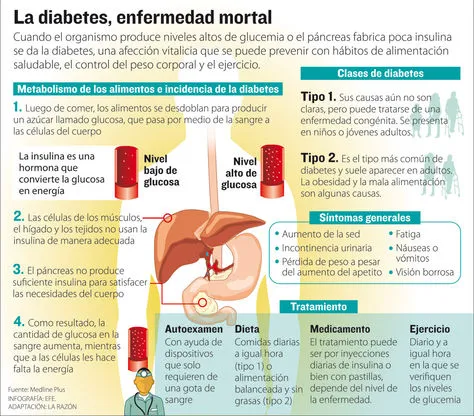The Ministry of Health will implement since 2016 diagnoses, laboratory exams and free diabetes treatments, within the framework of Universal Health Insurance.The plan will also cover the detection of people with obesity and hypertension.It works on the care strategy.
“What we will do yes or yes the following year, and for free, is the medical diagnosis and the laboratory exam to detect patients with diabetes.Based on that, a specific treatment will be established, which will also be free.That is a job that we are doing to include it to the Universal Insurance, ”the National Responsible for Epidemiology, Rodolfo Rocabado, informed yesterday.He added that the plan will also include the detection of obesity and hypertension, at no cost.Currently, health plans the strategy of these free services for the population.
However, Rocabado said that the public health centers of first and second level in the country will be the ones that will give attention and drugs, for free."We are working on the planning of all this to be ready in 2016."
Diabetes is a chronic disease that is characterized by the presence of high sugar (glycemia) levels in the blood.(See infographic).There are three types of diabetes, but the most recurring in Bolivia are type 1 and type 2, especially the latter.In the first case, patients should be treated with insulin injections;And in the second, with pills, in most cases.
Insulin comes in jars, each costs between Bs 80 and 100;Each patient uses two or three per month, depending on their state, explained the endocrinologist, Douglas Villarroel.“Those of type 2 are mostly treated with pills, which are not very expensive, but many cannot buy them.Of every 100 people with diabetes, 95 suffer from type 2, in our country. ”
As every November 14, the International Day against Diabetes will be commemorated on Saturday.In Bolivia, between January and August of this year, 54,000 new cases were reported, a figure that could exceed the 2014 report, which closed with 70,000, Rocabado said, warning that the incidence is increasing in the territory.The cities of the trunk axis have a higher incidence of diabetics.Santa Cruz and La Paz concentrate 50% of the total new cases.
The head of Epidemiology stressed that from this free policy it is intended to influence the prevention of this disease that leads to a high cost in health issues, since he recalled that the greatest complications are renal insufficiency, blindness, injuries in the systemNervous and blood vessels if there is no proper treatment.
"If the patient does physical activity and carries a balanced and healthy diet will control diabetes and will require very little medication," Rocabado said.Therefore, he considered it necessary to strengthen the proper diagnosis with the confirmation of a series of tests, which will be free for next year.
Cause of mortality
Disease
Diabetes, a noncommissible disease, is among the 10 main causes of death in the world, according to the World Health Organization.
80% of cases is due to eating habits
Of the 54,000 new cases of diabetes, registered by the Ministry of Health from January to August of this year, 80% (47,800) suffers from type 2, whose manifestation is due to bad eating habits, which mostly derives in obesity or obesityThe overweight, and there is also the little physical activity.“The bulk is in that group, in which Type 2, in 80%.Type 1 (congenital) has few cases, ”said Rodolfo Rocabado, national head of Epidemiology, of the Ministry of Health.
According to official health data, most cases are on the Troncal and Santa Cruz axis has the largestincidence, with 12,310 patients;Followed by peace, with 11,575 cases, both concentrate 50% of cases.Cochabamba has 5,000.
"The type 2 is the one that can be prevented and works a lot because it is the one that worries us the most," said Rocabado.He added that the main causes of high incidence are eating habits, since there is enough obesity and overweight."A walk automatically leads to a determining factor for diabetes, which is obesity," said the doctor.
According to the Non -Transmissible Diseases and Renal Health Unit, of the Departmental Health Service (Headquarters) La Paz, based on health centers, women are the most likely to acquire diabetes.The headquarters began a study to establish the incidence of kidney disease from diabetes tests
Douglas Villarroel Zambrana: ‘Many cannot pay drugs’
It is an important milestone with regard to the coverage of attention to people with diabetes in Bolivia and applaud the measure.I consider that it will make the difference in the lives of thousands of Bolivians suffering from this disease and suffering its consequences due to inappropriate treatments, due to the lack of economic resources.
The cost of evil treatment is very high and not only for the patient and his family, but for the State because this person ends with complications that are devastating health, such as blindness, embolisms, heart attacks, renal failure and amputations, andStop working and contribute to society.
If the State provides free medicines, it is already a great step to the prevention of complications or their own delay, and I consider that it will also result in death prevention.
Type 2 diabetes is the most common, it occurs in 95 out of every 100 diabetic patients;In the first years it must be treated with diet, physical activity and drugs that are not expensive, but many cannot pay it.Type 1, suffering from children and adolescents, is treated with insulin and the State should provide this medicine because it is essential for their life.
Prevention is important and is scientifically demonstrated that the development of type 2 diabetes can be prevented by up to 80% with walks, attacking overweight and with healthy nutritional plans.We work in a pilot plan in San José de Chiquitos (Santa Cruz) and we want that to be replicated in the country.
Douglas Villarroel is an expert in endocrinology.


